Fall 2020 at UC Berkeley: Masks, remote learning and courage
With an equity lens, intelligent minds and $10 million in instructional resources, the campus enters an unparalleled semester
August 24, 2020
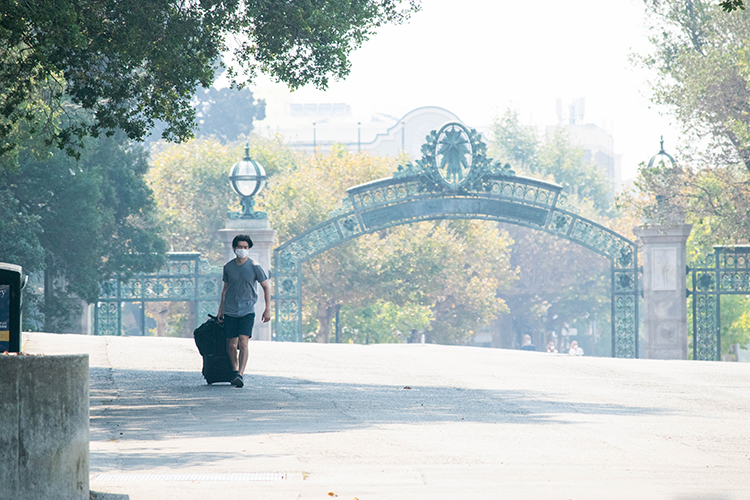
In a mask protecting him not only from COVID-19, but from smoke caused by California’s raging wildfires, a student wheels his belongings through the UC Berkeley campus. Instruction begins remotely on Wednesday; only 2,200 students will live in campus housing. (UC Berkeley photo by Irene Yi)
It’s hard to fathom that a new semester of instruction begins this week at UC Berkeley.
Most classrooms and offices are dark, fall sports are canceled, museum and library doors are locked. Sproul Plaza is void of tables set up by student groups to recruit new members, and nearby, no throngs of students pass beneath iconic Sather Gate.
The Campanile’s bells, played for concerts three times each school day since the 1920s, are silent, except for the Great Bear Bell that automatically strikes the hour.
But looks are deceiving on a campus closed by the coronavirus pandemic.
“Summer’s been the quietest one the campus has ever known, but also the busiest,” said Oliver O’Reilly, professor and outgoing chair of the Berkeley Academic Senate. “It’s been a heroic effort to get ready for the fall; we’re as prepared as we could possibly be.”
All-remote instruction, aided by $10 million in resources, begins Wednesday. Adhering to COVID-19 safety mandates, research continues, as do student public service efforts, student-athlete workouts, faculty office hours, health care appointments, Cal Band practices and campus construction projects. From the library to the stadium to the Basic Needs Center to student housing, creative workarounds to business as usual are flourishing.
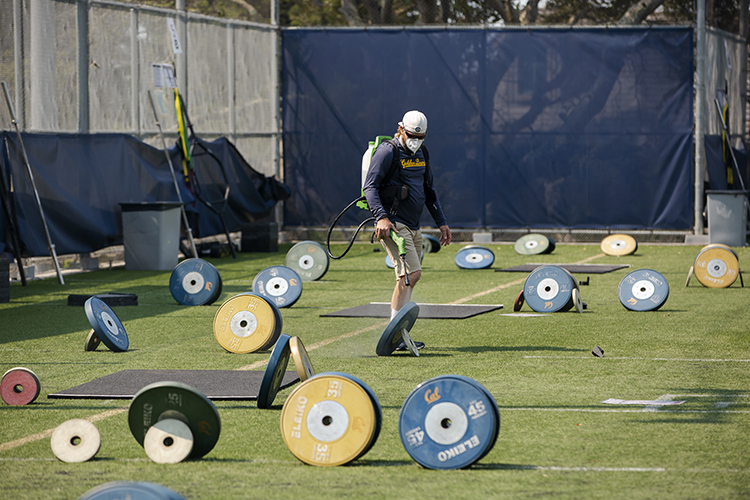
On Maxwell Family Field, a makeshift weight room during the pandemic, 38,000 pounds of weights transported there are disinfected after two sets of 12 football players, in masks and on opposite sides of the field, finished voluntary conditioning workouts. Currently, Berkeley Public Health guidelines only allow outdoor activities that can be done in small cohorts, using physical distancing, such as conditioning, running and weight training, for the campus’s student-athletes. (Photo by Brittany Hosea-Small)
And while it’s too early for final fall enrollment numbers, as of this week, the unofficial estimate is a student body numbering between 42,400 and 42,600.
At the undergraduate level, “so far, knock on wood, our enrollment is holding pretty steady,” said Cathy Koshland, vice chancellor for undergraduate education. According to the Office of Planning and Analysis, the projected undergraduate headcount for new and continuing students, as of last week, was between 31,000 and 31,200; last year, there were 31,348 undergrads in the fall census count.
The Graduate Division reports that, as of today, 11,387 graduate students are registered, compared to 11,693 at this point last year, but added that it’s still weeks away from being able to provide an official count.
An estimated 6,200 first-year, 2,500 transfer and 3,800 graduate students are joining the student body at an unprecedented time that’s been marked by not only COVID-19, but mass demonstrations against racial injustice, double-digit unemployment, a global financial crisis, rampant California wildfires and what’s been called “election stress disorder.”
“Despite all this chaos, incoming students are telling us they’re enthused about what they want to study, where they want to go, beyond this year,” said Berkeley physics professor Bob Jacobsen, dean of undergraduate studies. “And Berkeley is working hard to address every problem we can — we haven’t solved them, but we’re trying to address them.”
“Part of this is the resilience of the community,” he said. “We’re going to make this work. What’s our alternative?”
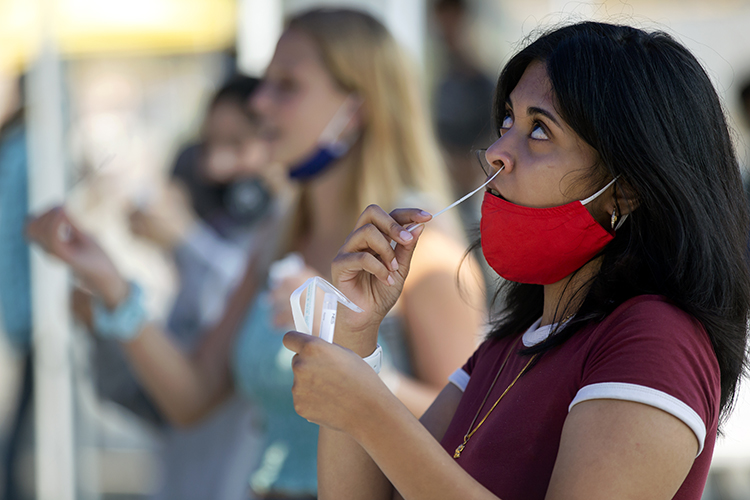
Like the other students in UC Berkeley’s residence halls this fall, Supria Sharma, a first-year student from New York, does the required COVID-19 nasal swab at a University Health Services tent before getting the key to her room. She’ll self-sequester, then take a second test in 7-10 days and, initially, two a week after that. (Photo by Brittany Hosea-Small)
Pandemic priorities
For many of the 2,200 incoming students whose best option was to live in campus housing this fall, the semester began with a COVID-19 test at University Health Services (UHS). It’s required of those in the residence halls, recommended for those in on-campus, apartment-style housing. Students will be tested again, after self-sequestering for 7 to 10 days, and then, initially, twice a week this semester. Living one to a room, the students in the residence halls are being assigned to residential social bubbles of 10 to 12 people and can’t bring in visitors.
Berkeley has set aside isolation and quarantine facilities in the Foothill housing complex and in Stern Hall for students diagnosed with COVID-19 who exhibit mild symptoms and for symptomatic students awaiting test results.
Students living off campus aren’t under the same rules, but Berkeley recommends they get tested and self-sequester, or quarantine for 14 days, any time they switch living locations and particularly after any air travel, in accordance with CDC guidelines.
Students, staff and faculty with mild symptoms or fear they may have been exposed to the virus can call the Tang Center for a free COVID-19 test, and all Berkeley graduate students, staff and faculty authorized to work on campus this fall can obtain free asymptomatic saliva testing (FAST) through the Innovative Genomics Institute.
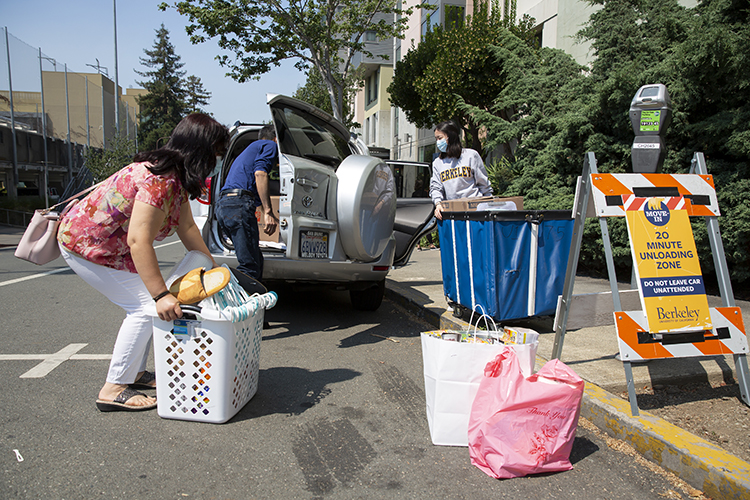
Move-in time at UC Berkeley’s residence halls typically means traffic and families searching for curb space. Not this year, with instruction taking place remotely during the pandemic. First-year student Kelly Ye and her parents, from San Francisco, had plenty of room to unload her belongings, and dorm check-in times were staggered to give everyone ample and safe space. (Photo by Brittany Hosea-Small)
All students coming onto UC Berkeley property this fall are required to accept the Keep Berkeley Healthy Pledge, vowing to protect themselves and each other from COVID-19.
Last week, first-year student Brianna Corces, in a UHS tent near the Tang Center, gamely learned to do her own COVID-19 nasal swab. Corces, the first college student in her family, said she’ll live in Unit 2, rather than with family in Whittier, because “at home, there are six of us, and I share a room, and I’m not able to study well. And I want to get the whole college experience.”
That’s a tall order, as she’ll attend class from her dorm room. But if she and other students look closely, student organizations, library resources, Rec Sports classes, undergraduate research apprenticeships, career fairs, freshman and sophomore seminars, DeCal courses, Berkeley Connect and hundreds of other academic and non-academic offerings are alive and well — albeit virtually.
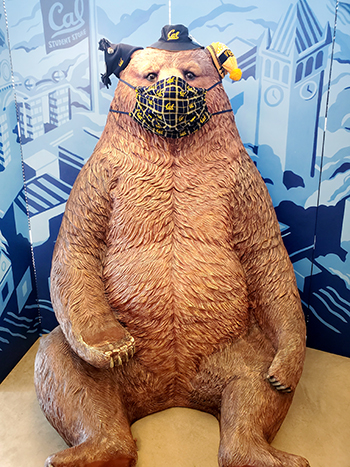
Inside the Cal Student Store, which is open, but only to a maximum of 25 customers at a time, all Golden Bears who shop — and live — there must wear masks. (Photo by Ivan Kreger)
Berkeley students also are active volunteers during the pandemic. In the campus’s own backyard, for example, the Public Service Center, partnering with the Berkeley Unified School District and Berkeley Schools Volunteers, is providing 75 to 100 personal student mentors to middle school students. They’ll meet biweekly with their mentees, lead after-school homework sessions and, as remote class aides, answer students’ questions in Zoom chat, so teachers can keep teaching.
“This is a very hard time for students, with everything switching to online, … and a hard transition for teachers,” said Laila Elias, a Berkeley senior and molecular and cell biology major who’s heading the volunteer program for Longfellow Middle School. “Public service is needed now more than ever.”
For Berkeley students curious about the virus that’s changing the world, new fall courses include “Pandemic Nation: Living With COVID-19,” “From Droplets With COVID-19 to Bubbles Under Ships,” “Flying Safe” (about post-pandemic aviation), “Genres of Plague: 1347, 1981, 2020” and “Economic Policy for the Pandemic.”
They also can dig into a variety of courses on current events, like the 2020 presidential race, or escape from the headlines with “Best Movies of All Time,” “Welcome to California in 14 Plants,” “Reading Walden Carefully,” “Beginning African Dance in Hip Hop” and other fall fare.
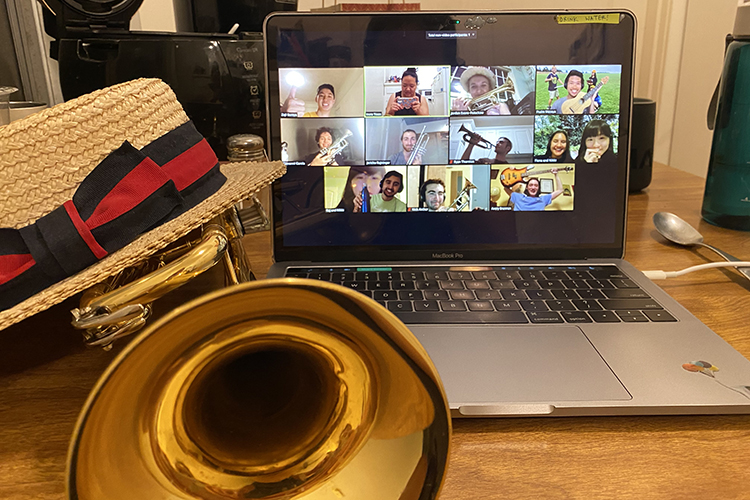
Sections of the Cal Band hold Zoom “bondings,” like this one for the trumpet players, to maintain the band’s tight-knit community during the pandemic. Not everyone has a trumpet at home; some musicians’ instruments are trapped in the band room of the César E. Chávez Student Center. (Photo by Irene Yoon)
Reconciling with remote instruction
Even before spring semester ended, the campus had a scenario for fall semester in which all instruction was remote. The work of two task forces produced recommendations to improve remote and online instruction and academic assessment, and all summer, instructors took part in workshops and support programs.
Resulting new initiatives include the development of a revised online resource for instructors, with continually updated FAQs for teachers and students; resources for best practices on remote instruction, compiled from across the globe; and guides for remote proctoring, alternative assessments, etiquette and equitable grading.
More than 1,000 faculty members enrolled in a course on best practices for remote instruction and the campus’s learning management system. And initiatives took off, such as Semester in the Cloud, a redesign of more than 30 large gateway courses and critical path classes for the fall, so that they’d offer the best in online pedagogy.
An anonymous donor provided $1 million that launched the Graduate Remote Instruction Innovation Fellows Program, which paid 260 graduate student instructors (GSIs) to attend an eight-week program to help the campus gear up for the fall. They each proposed a project, such as the redesign of a course, discussion section or syllabus, and worked closely with the instructors for the courses they’d be helping as GSIs to teach this fall.
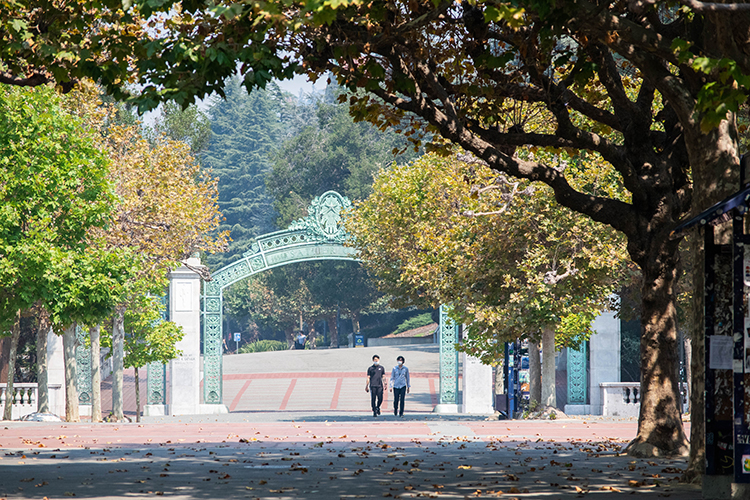
“This may be a perilous time, but so, too, is it a time of creative ferment and possibility, and that is prime time for this public university,” said Chancellor Christ told students on Friday, Aug. 21, in her livestreamed fall 2020 convocation address. (UC Berkeley photo by Irene Yi)
Many of the results were so stunning that students were asked to present them via Zoom to the faculty in their departments and at a virtual teaching conference held last week for 1,000 of Berkeley’s GSIs, said Linda von Hoene, assistant dean for graduate student professional development and head of the GSI Teaching Research Center.
“Faculty are going to be very grateful that they’ll have graduate student instructors who can help them with their remote instruction,” she said, adding that the GSIs had identified “approaches to teaching that really needed to be strengthened in courses, in person and online and ways to make learning spaces more inclusive and transparent, for the benefit of all students.”
Jeffrey Reimer, chair of chemical and biomolecular engineering, said many faculty “have had little or no experience with online technology, and not just ‘older’ faculty. Once it was clear that fall — by design — would be online, we realized we needed some expert opinions and resources. What technology works well? How does content delivery change? How do you handle students with special needs? How do you do office hours? The GSIs seemed like the perfect group to send to this fellowship program.”
Reimer wound up inviting one of the fellows, his former GSI, Elizabeth Corson, a Ph.D. candidate in chemical engineering, to speak at one of his department’s special summer faculty meetings on preparing for fall 2020.
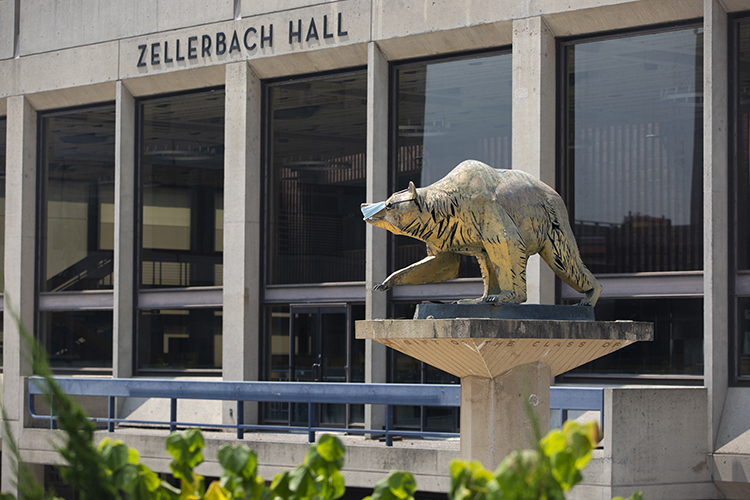
UC Berkeley is at work not only on best practices for remote instruction, but on using science, facts and creativity — like the mask on this bear statue — to motivate students to keep themselves and the campus community safe from COVID-19. (Photo by Brittany Hosea-Small)
Corson said the group eagerly engaged with the remote active learning techniques she’d planned, “like Zoom polls, breakout room discussions and collaborating on a Google document. They also asked good questions, some relating to technology solutions, others to best practices in Zoom. And many showed their concern and empathy for students.
“Many specifically identified techniques they’d learned that they’d implement in their own courses this fall, … and asked if they could share the documents I’d created with their GSIs, and the answer was, ‘Yes!’”
Still, said Reimer, winner of a coveted campus Distinguished Teaching Award, “there are faculty who fear that online COVID-19 times will persuade many that online education at Berkeley is good and will afford greatly increased enrollments. We are not drinking that Kool-Aid. The richest education for our students comes from small courses with faculty and GSIs and from individual research — the thing that the UC system, in the Clark Kerr scheme of things, was supposed to focus on.”
“The ‘facilitated and techno-fied’ presentation of information,” he added, “is a feared outcome of COVID-19 online instruction.”
O’Reilly said it’s important to remember that this focus on remote and online instruction “is not remote for the sake of remote, but because we’re in a pandemic. We have to be cognizant that everyone is doing their best to teach and learn, knowing the risks of face-to-face contact. We’re making the best of a difficult situation.”
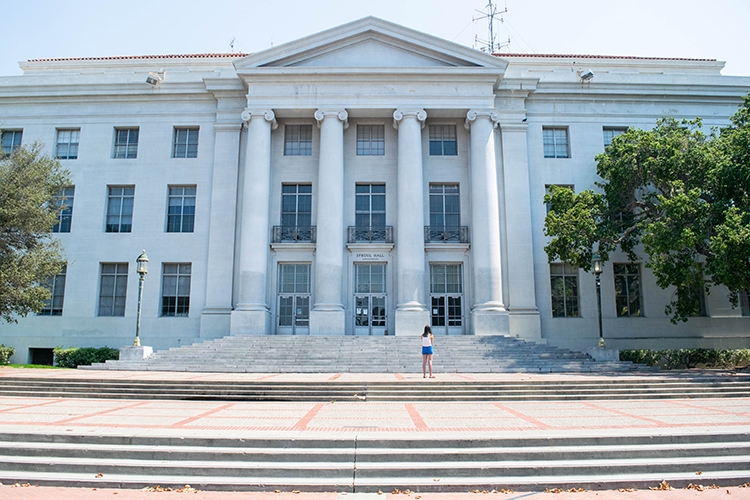
The pandemic has “highlighted and amplified deep racial and socioeconomic disparities among members of our campus community … we may all be in the same storm, but we are most certainly not all in the same boat,” said Chancellor Christ at fall convocation. (UC Berkeley photo by Irene Yi)
Addressing inequities exposed by COVID-19
At Berkeley after 9/11, recalled O’Reilly, “everybody said we should stop, take a moment to pause, but students wanted to go to class, wanted a sense of normalcy, wanted structure, to feel the familiar. If we completely stop teaching, the mission of the university would fail people. Teaching, learning and getting instruction help people cope with these situations.”
As does innovation, which, at Berkeley, is a frequent response to adversity. Last spring, for example, after COVID-19 forced the postponement of commencement, former and current students built Blockeley University, using the Minecraft video game, to help the Class of 2020 experience a ceremony in Memorial Stadium.
Students also churned out up to 450 gallons a week of hand sanitizer in campus labs this spring and partnered with community groups to donate it to at-risk populations in the Bay Area. The group has since grown from 15 to 115 active volunteers, about half of them affiliated with Berkeley, and is now called the Common Humanity Collective. In addition to hand sanitizer, the collective now also makes disinfectant wipes and high-efficiency filtration masks and, as of early August, had given out 4,570 gallons of hand sanitizer, 360,000 wipes and 7,140 masks.
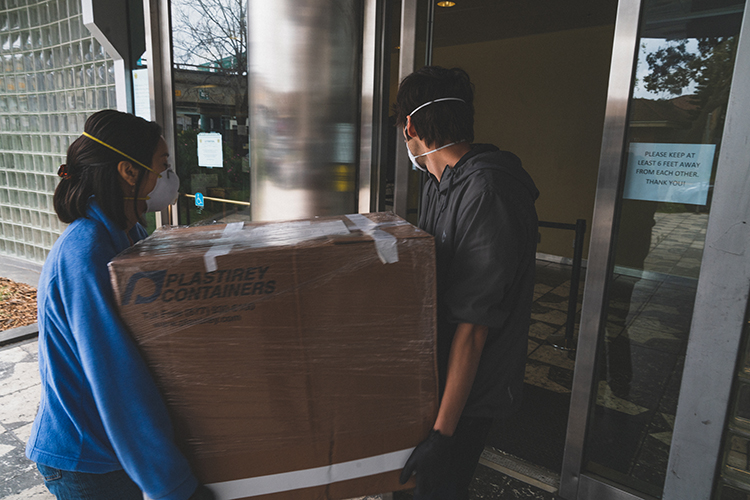
At the San Francisco County Jail, Abrar Abidi, a Ph.D. candidate, and research assistant Yvonne Hao, now in medical school at New York University, deliver enough free hand sanitizer, made in campus labs, for the 900 people incarcerated there to each have a bottle. (Photo by Ryland Hormel)
“When deciding where to go to grad school, … the spirit of Berkeley really appealed to me, and its history,” said Abrar Abidi, a Ph.D. candidate in molecular and cell biology, who co-founded the collective. “I’ve never been more grateful for choosing Berkeley, because so many people are willing to be altruistic, to help the ordinary stranger and people in need all around the bay.“
Fourth-year student Victoria Vera, the new ASUC president, said that, during trying times, the diverse lived experiences of the Berkeley community, coupled with its passion, “allows it to prevail in times of uncertainty, … to develop innovative ways of teaching and academics, but also to improve campus climate,” to make it more welcoming and just.
“Amazing inequities have been revealed during the pandemic,” said Koshland, “and we’ve been challenged to address those, to get a more level playing field. One thing revealed in the spring and summer has been the inadequacy of some students’ Wi-Fi at home, and their lack of other technology, like laptops.”
In response, the campus spent $4.6 million to buy several thousand laptops, hundreds of Wi-Fi hotspots and other equipment that is still being loaned to students in need through the Student Technology Equity Program (STEP). A new Disabled Students’ Program website, with a detailed FAQ for faculty, has resulted from more acute awareness of the academic needs of students with disabilities.
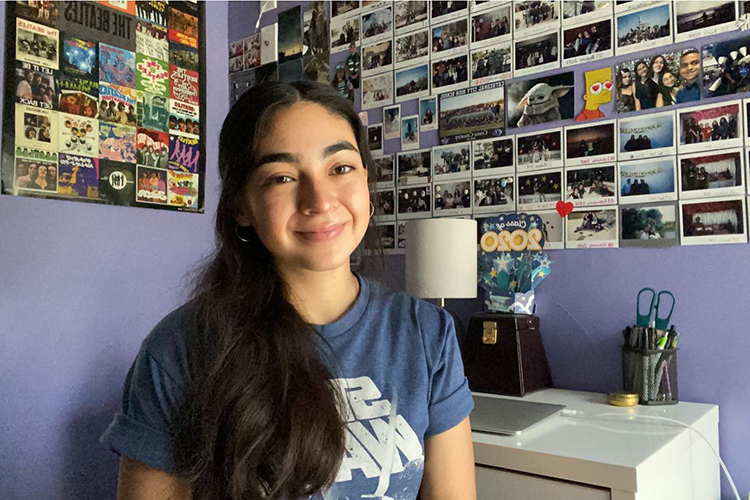
Instead of sharing a dorm room at Berkeley with her best friend from high school, Daniela Castillo is starting her first year at Berkeley from her room in her family’s home in Coachella Valley. (Photo by Daniela Castillo)
It’s especially vital, while physically distant from the campus, said Jacobsen, for students to open up and share with their professors and others on campus what isn’t going well for them.
“Some problems will be invisible, and that’s not good. Faculty don’t know everything that’s happening in every student’s life, … and students need to know their professors won’t strike them with lightning if they email them with the reality of their situations. They might not understand the implications of their students being in another time zone and having to get up for class in the middle of the night, or sharing a room with their little sister,” he said. “No one’s going to think less of students because of it. And we have to remember to help them.”
Starting first semester online “is definitely heartbreaking,” admitted incoming student Daniela Castillo, from Coachella Valley. Not knowing when she’ll finally arrive at her dream school, “feels like you’ve been running a race, and you can see the finish line, but as you get closer, the finish line moves further away from you.”
But after six weeks in Berkeley’s rigorous Summer Bridge transition program and having forged new connections with other first-year Berkeley students in her part of California, Castillo continues to run toward her goal — from her room, nearly 500 miles from campus.
“It’s not perfect, but it’s a start,” said Jacobsen of the semester that’s new, in so very many ways. “And the pandemic is eventually going to be over, and we will get back to where we want to be.”